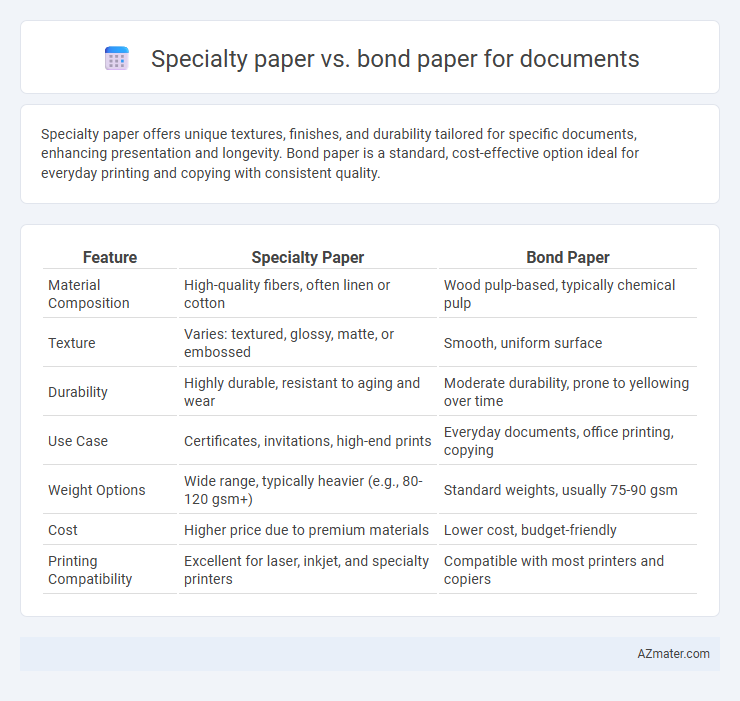Specialty paper offers unique textures, finishes, and durability tailored for specific documents, enhancing presentation and longevity. Bond paper is a standard, cost-effective option ideal for everyday printing and copying with consistent quality.
Table of Comparison
| Feature | Specialty Paper | Bond Paper |
|---|---|---|
| Material Composition | High-quality fibers, often linen or cotton | Wood pulp-based, typically chemical pulp |
| Texture | Varies: textured, glossy, matte, or embossed | Smooth, uniform surface |
| Durability | Highly durable, resistant to aging and wear | Moderate durability, prone to yellowing over time |
| Use Case | Certificates, invitations, high-end prints | Everyday documents, office printing, copying |
| Weight Options | Wide range, typically heavier (e.g., 80-120 gsm+) | Standard weights, usually 75-90 gsm |
| Cost | Higher price due to premium materials | Lower cost, budget-friendly |
| Printing Compatibility | Excellent for laser, inkjet, and specialty printers | Compatible with most printers and copiers |
Introduction to Specialty Paper and Bond Paper
Specialty paper is a category of paper designed for specific purposes, often featuring unique textures, colors, weights, or finishes tailored for particular applications such as invitations, certificates, or art projects. Bond paper, commonly used in offices, is a high-quality, durable writing paper typically made from cotton or wood pulp, ideal for everyday printing, letterheads, and official documents. Understanding the distinct properties of specialty paper and bond paper helps in selecting the appropriate material based on the document's purpose and required presentation quality.
Defining Specialty Paper: Key Features
Specialty paper encompasses a wide range of materials designed for specific printing or artistic needs, including textured surfaces, enhanced durability, and unique finishes like gloss, matte, or metallic. These papers often feature higher weight, custom coatings, and superior brightness levels compared to standard bond paper, making them ideal for high-quality presentations, invitations, and archival documents. Unlike bond paper, specialty paper is formulated to provide enhanced tactile and visual appeal, ensuring professional-grade results for specialized applications.
Understanding Bond Paper: Characteristics and Uses
Bond paper is a high-quality, durable paper commonly used for official documents, letterheads, and forms due to its strength and professional appearance. It typically has a weight between 16 to 24 pounds and a smooth finish that enhances ink absorption for clear, crisp printing or writing. Its acid-free nature ensures longevity, making bond paper ideal for archival purposes and documents requiring durability over time.
Comparing Paper Weight and Thickness
Specialty paper typically offers higher weight and greater thickness compared to bond paper, enhancing durability and a premium feel for important documents. Bond paper usually ranges from 16 to 24 pounds with a thinner profile, ideal for everyday printing and copying needs. In contrast, specialty paper can exceed 40 pounds and provide a more substantial texture, which is preferred for formal presentations and high-quality printed materials.
Print Quality: Specialty vs Bond Paper
Specialty paper offers superior print quality compared to bond paper, featuring a smoother surface and higher brightness that enhances color vibrancy and sharpness in printed documents. Bond paper, while more affordable and suitable for everyday printing, typically absorbs more ink, resulting in less crisp images and text. For high-resolution prints, specialty paper ensures greater detail accuracy and professional finish.
Durability and Longevity Considerations
Specialty paper, designed with enhanced fibers and coatings, offers superior durability and resistance to wear, moisture, and fading, making it ideal for long-term document preservation. Bond paper, commonly used for everyday printing, has a lower durability level and is more prone to yellowing and tearing over time. For archival quality and documents requiring extended lifespan, specialty paper provides a significant advantage in maintaining document integrity.
Aesthetics: Texture, Color, and Finish
Specialty paper offers unique textures, vibrant colors, and diverse finishes such as glossy, matte, or embossed, enhancing the visual appeal and tactile experience of documents. Bond paper typically features a smoother texture with a more uniform white or off-white color, providing a clean and professional look ideal for standard printing. The choice between these papers depends on the desired aesthetic impact and the document's purpose, as specialty paper elevates presentation while bond paper emphasizes clarity and simplicity.
Cost Analysis: Specialty Paper vs Bond Paper
Specialty paper typically incurs higher costs due to unique materials, finishes, or textures tailored for specific uses, such as invitations or certifications, resulting in premium pricing compared to standard bond paper. Bond paper offers a cost-effective solution ideal for everyday printing and copying, with prices significantly lower owing to its mass production and simple composition. Businesses should weigh the added expense of specialty paper against its enhanced aesthetic and functional benefits to determine the best fit for their document needs and budget constraints.
Environmental Impact and Sustainability
Specialty paper often uses recycled fibers and alternative materials, reducing deforestation and lowering carbon footprints compared to traditional bond paper, which typically relies on virgin wood pulp. The production of specialty paper generally incorporates eco-friendly processes such as reduced water and energy consumption, enhancing its sustainability profile. Choosing specialty paper for documents supports environmental preservation by minimizing waste and promoting resource efficiency.
Choosing the Right Paper for Your Document Needs
Specialty paper offers unique textures, colors, and finishes ideal for professional presentations, certificates, and creative projects, enhancing the document's visual impact. Bond paper is a durable, versatile choice commonly used for everyday printing, letterheads, and official documents requiring clarity and longevity. Selecting the right paper depends on the document's purpose, desired aesthetic, and printing requirements to ensure optimal readability and presentation quality.

Infographic: Specialty paper vs Bond paper for Document
 azmater.com
azmater.com